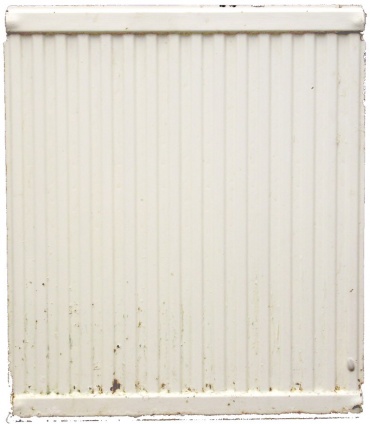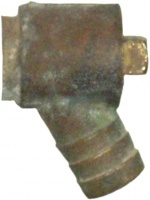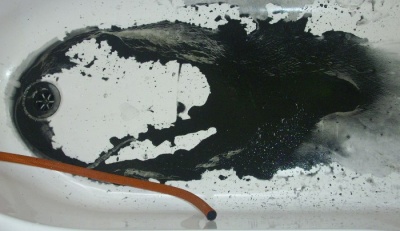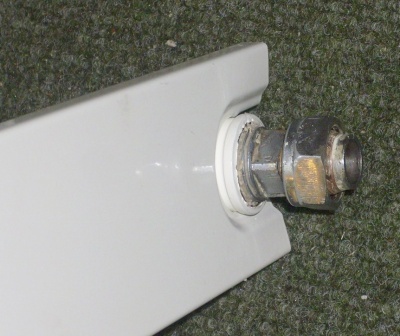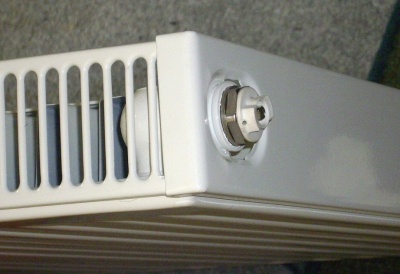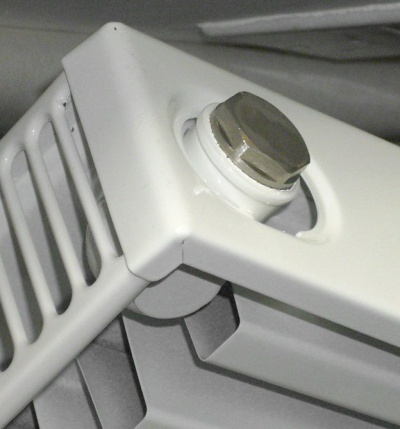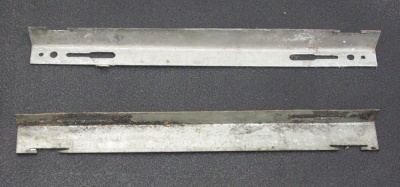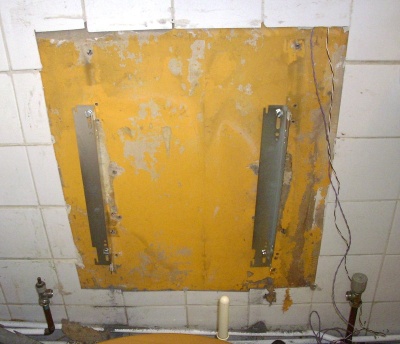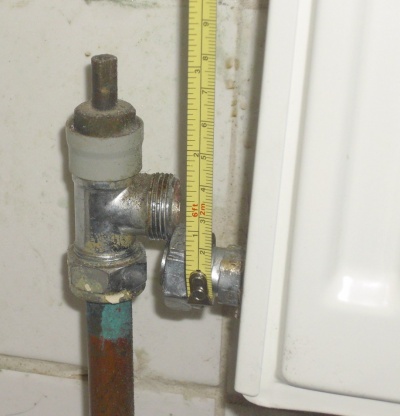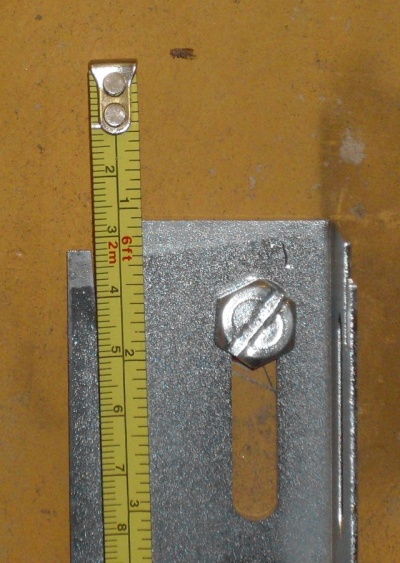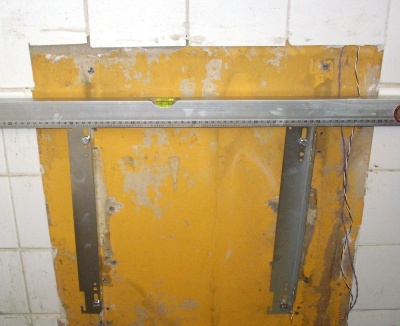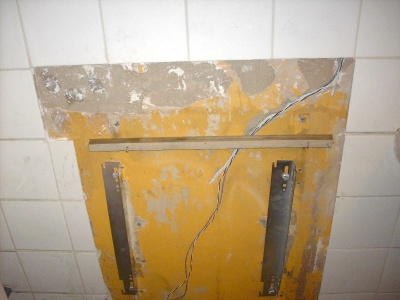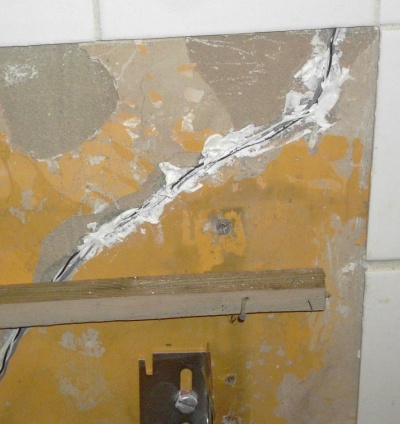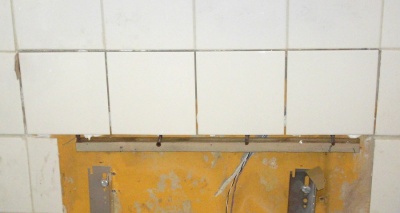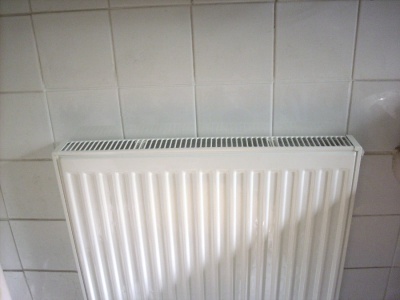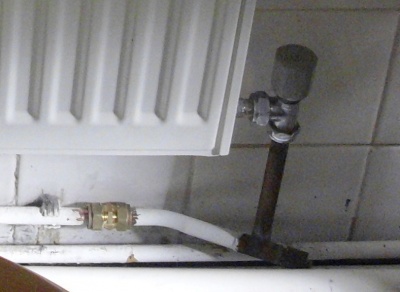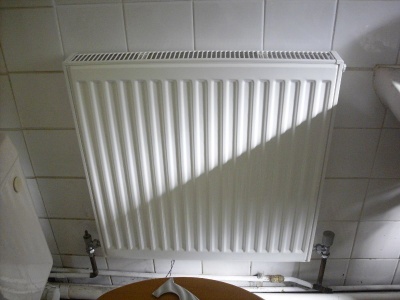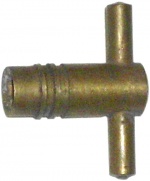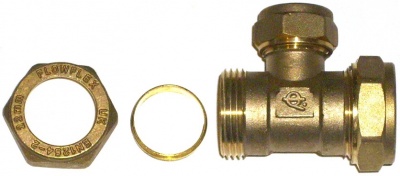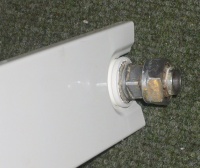Difference between revisions of "Replace a radiator"
(→Olives: linkify) |
m (→See also) |
||
| Line 193: | Line 193: | ||
[[Category:Plumbing]] | [[Category:Plumbing]] | ||
[[Category:Tiling]] | [[Category:Tiling]] | ||
| + | [https://hasslefreeboilers.com/how-to-bleed-a-radiator/ How to bleed a radiator?] | ||
Revision as of 11:49, 26 July 2017
This radiator needs replacing.
If the new rad were the same size, the 2 valves could just be switched off and the rad replaced, with only the water in the radiator to deal with.
The new rad is slightly smaller though, so its necessary to cut the pipework. There are 3 ways to avoid a mess:
- A bung in the header tank, close off the rad valves, only make one pipework hole at once
- Pipe freezing kit - speed & confidence needed
- Drain down the system, adding new inhibitor afterwards - allows multiple pipe cuts, pretty foolproof
In this case there was other work to do as well, and a drain down was chosen as the easiest option.
- Turn the water feed to the heating system off or tie the header tank ballcock up
- Set the programmer to OFF for both CH and HW.
- Put a hosepipe onto the drain cock to empty the system. Weight the outlet end so it doesn't move and flood the place.
- Loosen the drain cock end nut, but don't remove it. It will leak, put a bowl under it.
- Loosen the radiator bleed valve at the top so the rad can also drain.
When all drained, the nuts on the radiator tails were undone, enabling the rad to be lifted off. Bigger rads need 2 people to lift.
When you lift the radiator off, don't tip it over or the evil sludge spills out.
The rad valves are ok, and the tails were unscrewed from the old radiator for reuse. The threads were cleaned out & filled with putty. The new rad also had its threads wiped with putty, and the tails screwed into it as shown.
The bleed valve is screwed into the new rad at the top at the more accessible end.
The other top end hole is blanked off. The blanking plug and bleed valve came with the new radiator.
The enclosed wall fixing diagram wasn't too helpful, so the rad brackets were held in place on the rad, and the lower left bracket fixing hole measured from the left tail, horizontal and vertical distances being taken. The brackets can move up & down on the wall, and the rad can move sideways on the brackets; middle positions were measured from to permit later adjustment in any direction.
These measured distances were used to mark the position of the first fixing hole on the wall, measuring from the disconnected pipe end. (Don't forget to hold the pipe in its desired final position.) The other 3 bracket fixing holes were measured from the 1st one, and marked on the wall.
Didn't have a 9mm SDS drill bit, so drilled the fixing holes 10mm and put some slices of plastic in the holes so the wall plugs fit snugly. Fixing screws & wallplugs came with the rad, and were more than big enough, so for once the supplied fixings were used.
Rad brackets fitted to the wall, but screws not tightened up yet, bracket positions still need fine adjustment.
The rad was placed on the brackets, and how far up the left one needed to move was measured.
The distance to move the bracket up was marked on the wall, makes life easier.
The bracket was moved up to the mark and tightened. The other bracket was moved up to make them level and tightened.
The new rad is a bit shorter than the old, so the top row of half tiles have been removed, and a strip of wood nailed on (with masonry nails) to support the new row of tiles while they set.
The old tiles, which were dot & dabbed, were removed by
- cutting through the grout to physically disconnect the keep and remove tiles.
- insert screwdriver under the remove tiles and lift, while keeping the other hand firmly on the keep tiles to prevent even the slightest movement (0.1mm is too much)
- knock off any lumps of adhesive left on the wall
If the old tiles had been stuck with a flat bed of adhesive, they would have needed chiselling off.
The LED lit mirror has a 5v feed fitted under the tiles. So a shallow channel for the wires has been cut with an SDS chisel. The chisel was just bounced along the surface to make the groove.
The wires are pressed into tile adhesive in the channel. Neatness is clearly vital.
The tiles are stuck on. As the wall is uneven, each tile gets 5 dots of adhesive and is pressed/wiggled into position. Each tile must rest on something while it sets to stop it sliding out of position, hence the wood strip, folded card, and for the bigger gaps here wallplug offcuts were just right.
If the wall were flat, wiping adhesive onto the back of the tiles with a notched tiling spreader would be better.
Next day the adhesive's set, though still weak. The tiles are grouted - its only a small area so the grout was just pressed deep into the gaps with a finger, then wiped smooth along the gap. The finish on neighbouring grouting was rough, so the grout lines were finger wiped to produce the same kind of finish. A rubber grouting tool wiped at 45 degrees would produce a smooth finish.
The rad was hung on its brackets, ready to connect to the left valve on the pipe end. The correct way is to remove the old olive and fit a new, but unfortunately the nut on both rad tails couldn't be slid back far enough to get any access to the old olives. With no new tails on hand I went for the practical option and packed the outer nut completely full of putty, did it up and tried to convince myself it wasn't a bodge. As its tightened up this putty gets forced over & around the old olive, and that's how the seal is made. Purists will groan, but its perfectly effective, and saved a trip out and unnecessary mucking about.
The new rad was 3cm less wide than the old, so to connect the right end up the pipe was shortened.
- A 3.5cm length was cut out using a rotary pipecutter
- Accumulated paint was sliced off with a knife for an inch on the 2 cut ends
- A metal scourer cleaned the pipe surfaces
- A 15mm coupler was screwed on after smearing the olives inside and out with putty, and done up firmly.
- With hands 4&5, the connection to the end of the rad was done up at the same time.
Done!
The water feed was turned back on, keeping an eye on the repairs for leaks. Everything was sound.
The radiators were all bled. Loosen the bleed valve with a bleeding key, air hisses out, once water begins to come out do it up again, not very tight. If the floor isn't wipe clean its best to hold an old towel under the bleed valve to catch the dirty drips.
The programmer was set back on and inhibitor was put in the CH header tank (the little 2 gallon tank in the loft). That's it.
Olives
Compression fittings use thin copper or brass rings called olives. Olives are designed to be used dry, with no other sealant or ptfe. I've had too many leaks doing this, I smear olives inside & out with sealant or putty and it works every time. Purists will tell you not to.
In case you've never plumbed anything before, olives aren't reusable. Even if you gently screw home the nut on an unused fitting the olive will no longer be usable. Every job needs a spare olive or two.
With these compression fittings, the threads don't form a watertight seal. The seal's formed between the olive and the pipe, and a second seal forms between olive and the fitting around it.
Why then was gloop put in the threaded nut during the installation? This isn't usually done, but when reusing an old olive is unavoidable, its probably not going to make a seal, and the putty in the nut gets squeezed all around the olive as the nut is done up, creating a seal.
Sealants
Several sealant options for pipe joints:
- No sealant other than the metal olive
- Plumber's mait - never sets
- Silicone sealants like LS-X
- PTFE tape - easy & clean. Wind it the right way so it doesn't undo as you screw the nut up
- Gas grade PTFE - tougher than the cheaper plumbing grade
- Linseed putty - non toxic but not for potable water
- Hemp fibre & jointing compound (eg boss white) - slow, no longer a popular method
This job was all done with linseed putty. It does set hard, but unscrewing a joint later breaks it up without any difficulty, there's only a thin film left in the joint. Purists won't like that either.
See Putties
Tails
This rad used standard straight tails that take a compression fitting on the valve end, and have a 1/2" BSP male thread on the rad end. Its also possible to find tails that are conical at the valve end.
The old tails were re-used this time, but there are 2 other options:
- fit new tails
- use a long adjustable radiator tail to deal with the change in rad width, such as this.
- long & adjustable versions of both tail types are available
Basic Info
Good tools for undoing pipework nuts are
- pipe wrench when tight
- waterpump pliers when not too tight, they're much quicker to use
- spanners
Its wise to support the valve etc against rotation when undoing a nut, otherwise its possible to rotate the whole assembly and buckle the copper pipe.
The drain cock is somewhere on the pipework at the lowest point of the heating system.
See also
- Radiator
- Central Heating Repair
- Putties
- And click the category links below.
